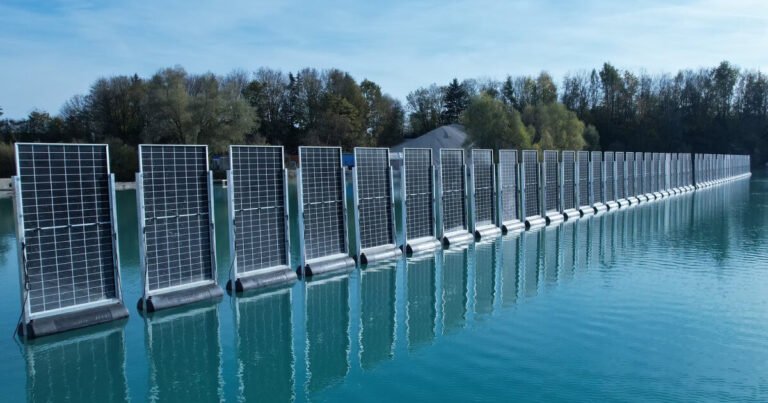Large-Scale Wind and Solar Projects Are Harming Biodiversity, Scientists Warn
As the world races to cut carbon emissions, vast wind and solar farms are now a common sight across lands and waters once considered untouched. At first glance, it seems we’re making real progress by moving away from fossil fuels. However, there’s a growing issue few discuss—the silent toll this green transition may be taking on nature itself. Are these clean energy solutions quietly harming the very ecosystems they aim to protect?
You’d think renewable energy would be harmless to the environment—after all, it’s promoted as a planet-saving solution. But increasingly, scientists are warning that building large-scale wind and solar farms in the wrong locations can seriously damage the ecosystems we’re striving to preserve.
In Australia, for example, experts in late 2023 called for an immediate pause on new large-scale renewable energy projects in ecologically sensitive areas. Jeanette Kemp, a former Queensland government botanist, described the situation as a looming “death by a thousand cuts,” where wind turbines and solar arrays gradually fragment remote native vegetation, disrupting habitats bit by bit.
Professor Hugh Possingham added that without detailed biodiversity mapping, we risk placing infrastructure in “no-go zones” rather than steering development toward already degraded land. And this isn’t just an Australian problem. A global assessment covering over 15,000 key biodiversity areas found that 5% already host mining, 14% contain oil and gas facilities, and up to 2% house existing energy infrastructure. As the renewable energy footprint grows, so does the risk of biodiversity fragmentation from roads, power lines, turbine pads, and panel arrays, chipping away at the integrity of continuous habitats.
Studies show that such fragmentation can reduce biodiversity by anywhere from 13% to a staggering 75%, disrupt nutrient cycles, and alter species movement and reproduction. While renewable energy is essential, we must ensure it doesn’t come at the expense of vital ecosystems. Clean energy should not cost us biodiversity. Without thoughtful planning, strong protections, and a focus on using already degraded landscapes, we risk sacrificing irreplaceable habitats—and the wildlife that depends on them—in our rush to decarbonise.

Real-World Impacts & Insights
1. Scotland’s Offshore Wind vs. Seabirds
Scotland has been a leader in offshore wind, but recently several projects have stalled because experts found significant risks to seabirds. Developers and regulators are especially concerned about seabirds like kittiwakes, guillemots, razorbills, and puffins, which fly through turbine arrays and may collide with blades or be displaced from their feeding or migratory routes. One proposed project—Berwick Bank, with 307 turbines—was delayed after models predicted hundreds of annual seabird deaths and irreversible damage to Special Protection Areas.
Scientists now use integrated collision and displacement models along with AI and radar tracking to better predict risks, but regulators remain cautious, slowing permits until seabird safety is ensured.
2. Australia: Clearing the ‘Green Frontier’
In Queensland and New South Wales, hundreds of square kilometres of koala and glider habitat have been approved for clearing to make way for renewable projects. Since 2012, solar, wind, and battery sites have cleared around 6,800 ha of koala habitat — nearly 20% of total losses among development types — and over 13,000 ha more is pending approval, potentially accounting for 42% of future habitat loss. Concerned planners say repeated warnings to governments about habitat fragmentation for iconic species fell on deaf ears. In one rare victory, proposed wind turbines at Wooroora Station—inside Queensland’s Wet Tropics World Heritage Area—were cancelled this year after environmental campaigns. This shows that strong oversight can still protect nature.
3. Australia’s Offshore Wind in Bass Strait
Australia’s first major offshore wind zone was established in the Bass Strait—a vast 7,100 km² area off the coast of Tasmania. It promises clean energy and economic benefits. However, marine experts and bird watchers warn that the stakes are high: albatrosses, migratory seabirds, and whales all pass through these waters. Critics argue that long-term bird-tracking studies should be conducted before turbines are installed, as the wind sector may disrupt critical marine wildlife even more than coastal energy projects. It’s a reminder that green energy isn’t always harmless, especially if we fail to understand nature first.
4. UK Solar Farms: A Biodiversity Success Story—When Managed Right
Not all is doom and gloom. A joint study by the Royal Society for the Protection of Birds (RSPB) and the University of Cambridge, published in February 2025, found that well-designed solar farms in the UK hosted nearly three times more bird species and double the number of individual birds compared to neighbouring cropland. Another nationwide report examining 124 sites across Britain recorded 7,400 birds from 94 species, including threatened varieties, along with flourishing wildflowers, insects, and robust hedgerows.
The secret lies in intentional land management: integrating wildflower strips, hedgerows, and reduced mowing creates a patchwork of microhabitats. These features don’t just mitigate environmental harm—they actually turn solar sites into biodiversity hotspots.
A March 2025 study in East Anglia supports these findings. Researchers discovered that solar farms tailored for wildlife—with pollinator-friendly plants and minimal disturbance—supported significantly more biodiversity than adjacent agricultural land. During spring surveys, these enhanced sites hosted more than 90 bird species, including red- and amber-listed birds like Corn Buntings, Yellowhammers, and Linnets.
Other research reveals similar outcomes: pollinators and small mammals also flourish on solar farms managed with nature in mind. Rather than sterile zones of energy production, these sites serve as unexpected refuges for wildlife, demonstrating that it’s possible to meet clean energy goals while protecting and even restoring local ecosystems.
The Science Behind the Impacts
Grassland Plants
A recent study in Inner Mongolia looked at how wind farms reshaped grassland plant communities. Researchers surveyed 108 field plots around turbines and analysed ten plant traits. They found that areas near turbines had noticeably less species richness, lower productivity (measured as biomass), and reduced phosphorus content in the vegetation. Even the variety of functional traits—in things like plant height and leaf characteristics—became more uniform, which scientists call “community convergence.” According to this research, wind turbines are linked to local declines in plant diversity and nutrient richness in Inner Mongolia’s grasslands.
Birds
A broad study in China compared counties with varying numbers of turbines and reported that for every 84 additional wind turbines installed, bird abundance dropped by about 9.8%, and bird species richness declined by 12.2%. Such reductions often stem from habitat displacement, collision risk, and disturbances, especially for migratory birds and forest-dwelling species that avoid turbine zones.
Bats
Every year, wind turbines in North America are estimated to kill hundreds of thousands of bats. But there’s hope. Research shows that by raising the “cut-in” wind speed—the speed at which turbines start—bat deaths drop significantly. A USGS meta-analysis found that increasing this speed by 1 m/s cut bat fatalities by about 33 %, and raising it to 5 m/s cut fatalities by around 62 % on average. A smart, AI-driven curtailment trial in Wisconsin reached an impressive 85 % reduction in bat deaths without hurting energy output. In Australia, boosting the trigger point from 3 to 4.5 m/s saved 54 % of bats, with hardly any energy loss.
Marine Life
Offshore wind farms introduce a completely different dynamic under the ocean’s surface. Construction noise and vibrations from pile driving can temporarily displace fish, marine mammals, and invertebrates, and researchers caution that these disturbances need careful planning to avoid long-term harm.
On the flip side, once operational, the turbine foundations act as artificial reefs. Studies in the North Sea and the Netherlands have shown that these structures can become hotspots for marine life—filter feeders like mussels and barnacles move in, and fish such as cod and bass follow. In fact, some sites report up to 200 times more biomass around turbines than in surrounding soft-bottom areas.
Moreover, one recent study using environmental DNA in the Netherlands detected rays and sharks lingering near turbines, suggesting new habitats are forming in these artificial ecosystems.
Still, gaps remain. The Plymouth Marine Laboratory noted that more than 86% of potential ecosystem service impacts from offshore wind are still not well understood, including how invasive marine species might latch onto turbine structures and travel to new habitats.
Invasive Plants
Wind farm construction can disturb soil, creating ideal conditions for fast-growing invasive plant species. For example, in Norway, ruderal species rapidly colonised disturbed plots, outcompeting native vegetation and altering the local ecosystem structure. Similarly, offshore wind platforms can facilitate the spread of invasive marine species by serving as “stepping stones” along coastal areas. These non-native organisms may displace local species and disrupt the ecological balance.
Mitigation Measures: What the Experts Recommend
Experts strongly recommend “smart siting,” meaning wind and solar farms should never be placed where they harm biodiversity hotspots, migratory corridors, or critical habitats. According to BirdLife International, siting decisions alone can prevent major wildlife losses.
Design adaptations also make a big difference. Painting just one turbine blade black has been shown to cut bird collisions by nearly 70%, as a study in Norway demonstrated. Meanwhile, AI-based curtailment systems like IdentiFlight use cameras to detect eagles in real time and automatically stop turbines, reducing eagle deaths by up to 82%.
Operational changes matter too. Many bats die when turbines operate on low-wind nights, as they mistake the spinning blades for open space. Dr. Sutter, a wildlife technology expert, explains, “Echolocating bats perceive turbines as open space, and fatal collisions result. Smart curtailment based on machine vision can dramatically reduce fatalities.”
Other measures include burying or marking power lines to prevent bird electrocution and incorporating wildflower margins, hedgerows, and native plants beneath solar panels to support local ecosystems.
Offshore wind farms can even help marine life if built thoughtfully. Researchers have found that textured foundations act like artificial reefs, creating shelter and food sources for fish and invertebrates.
Patricia Zurita, CEO of BirdLife International, puts it perfectly: “Building back better… must ensure that wind and solar have safeguards to avoid impacts on key areas of biodiversity.”
In the end, clean energy and thriving wildlife can go hand in hand—if we put nature at the centre of every decision.
Learn More: Pros and Cons of Wind Farms
Actionable Advice: Balancing Energy & Nature
Governments & planners should:
- Map no-go biodiversity zones. Before approving energy projects, planners must identify and map critical habitats—like nesting grounds, wetlands, and migratory corridors—and legally protect them. This ensures development avoids ecologically sensitive areas entirely.
- Mandate environmental assessments. Require full pre- and post-construction ecological reviews. These assessments can reveal risks to wildlife and habitats early, allowing mitigation strategies before damage occurs.
- Tie incentives to biodiversity metrics. Financial support—like subsidies or tax breaks—must depend on measurable environmental performance, such as maintaining native plant cover, supporting pollinator presence, or reducing wildlife mortality.
Developers must:
- Use pre-construction surveys. Conduct thorough surveys to identify local wildlife—including birds, bats, and insects—and tailor mitigations accordingly.
- Incorporate blade-painting, smart curtailment & line-marking.
- Design habitat-enhanced solar parks. Integrate native plantings and micro-habitats under panels. The National Renewable Energy Laboratory found that solar parks planted as prairie support pollinator abundance equal to conservation land.
Researchers & NGOs should:
- Promote long-term ecological monitoring.
- Evaluate innovative mitigation. Test novel tactics like blade paint mixes, artificial reefs for offshore turbines, or reef-inspired turbine foundations to boost marine biodiversity.
Communities can:
- Advocate for dual-purpose renewable projects. Projects like pollinator solar—agrivoltaics—combine energy and ecology, benefiting bees, butterflies, and soil health.
- Collaborate in citizen science. Residents can help track wildlife around renewables—identifying nesting patterns, fatalities, and species presence—providing valuable data to improve practices.







